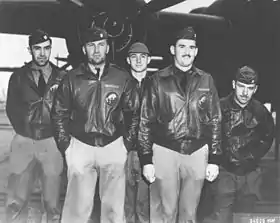Chase Nielsen
Chase Jay Nielsen (January 14, 1917 – March 23, 2007) was a career officer in the U.S. Air Force. He participated in the Doolittle Raid in 1942 and was one of the four surviving prisoners of war from that raid. Nielsen was a member of The Church of Jesus Christ of Latter-day Saints.

Born in Hyrum, Utah, Nielsen attended Utah State University and graduated in 1939 with a bachelor of science degree in civil engineering. In August 1939, he enlisted in the U.S. Army Air Corps as a flying cadet. He was commissioned as a second lieutenant in June 1941.
Lieutenant Colonel Nielsen, a lieutenant at the time, was the navigator of The Green Hornet, the sixth B-25 to launch from the deck of the USS Hornet on April 18, 1942. Most of the aircraft were able to reach land (but did not land due to low or no fuel) after their mission, but two, including Colonel Nielsen's, were forced to ditch off the coast of China. Two men were killed in the ditching.
Eight men in all were taken prisoner by the Japanese and held in inhumane conditions from which four survived. Along with Robert Hite and Jacob DeShazer, Colonel Nielsen spent 40 months as a prisoner of war, most of the time in solitary confinement, before being rescued (August 20, 1945) at the end of the war by an Office of Strategic Services para-rescue team and brought back to the U.S.
Colonel Nielsen returned to Shanghai, China, in January 1946 to testify in the trials against his former captors, who had tortured him with waterboarding, then called the "water cure."[1] Extracts from his testimony were later presented at the Tokyo Trial.
Colonel Nielsen became a member of Strategic Air Command (SAC) in March 1949 at Roswell AFB, New Mexico, where he was assigned to the 509th Bombardment Group, the first group to be organized, equipped and trained for nuclear warfare.
During his decade with SAC, Colonel Nielsen helped the command develop key operational innovations, including radar navigation bombardment, air refueling employing the flying boom, and electronic countermeasures. He helped integrate "fail safe" and other emergency war order procedures into SAC's unique set of flight profiles.
Colonel Nielsen returned to the air while assigned to SAC and reached more than 10,000 flying hours in B-29s, B-50s, B-36s and B-52s. His longest flight lasted 26 hours non-stop without refueling from Okinawa, Japan, to Walker Air Force Base, in a B-36.
Lieutenant Colonel Nielsen retired from the Air Force in 1961 and began a career as an industrial engineer with the Ogden Air Logistics Center at Hill Air Force Base, Utah. He retired in 1981.
Colonel Nielsen's decorations include the Distinguished Flying Cross, the Purple Heart with Cluster, the Air Force Commendation Medal with Cluster, Outstanding Unit Award, Longevity Ribbon with four Clusters, and the Breast Order of Pao Ting (Order of the Sacred Tripod) from the Republic of China.
Lt Col Chase Nielsen died at his home in Brigham City, Utah, March 23, 2007 at the age of 90.
See also
- Fellow Green Hornet (plane #6) crew member Sgt. William J. Dieter (bombardier)
References
- Wallach, Evan (November 4, 2007). "Waterboarding Used to Be a Crime". The Washington Post.
- Lt. Col. Stephen Clutter (March 25, 2007). "Air Force legend Col. Chase Nielsen passes away". U.S. Air Force Print News. Archived from the original on 2012-12-12.